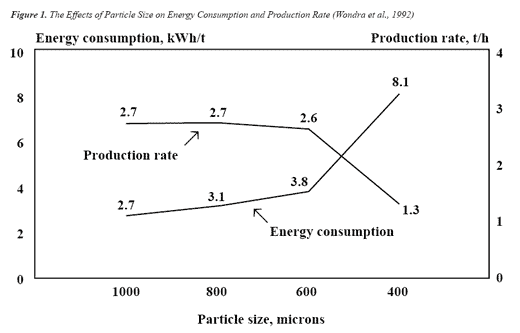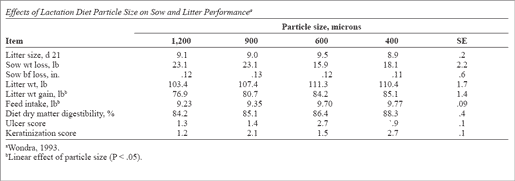The Effects of Diet Particle Size on Animal Performance, Part 2
Particle Size and Alternative Grains
The type of grain in the diet also will influence the pig's response to particle size reduction. Studies with high-fiber feed ingredients like barley indicate fine grinding of these types of ingredients may greatly improve their feeding value. A study was conducted with finishing pigs fed diets containing barley ground through a hammermill equipped with either a 1/8-, 3/16-, or 1/4-inch screen or coarsely rolled (Table 4). Performance of pigs fed these diets was compared to those fed a diet containing milo ground through a 3/16- inch screen.
Pigs fed the barley diet ground through the 1/8-inch screen had similar average daily gain and feed efficiency compared to pigs fed the milo diet. Daily gain and feed efficiency became poorer as particle size of the barley diets increased. These data indicate grinding of fibrous feed ingredients to approximately 700 microns improves their feeding value and may make them more attractive as substitutes for corn and milo.
Because of its high protein content and propensity to become floury, wheat presents some unique processing problems. If ground too fine, wheat can reduce feed intake. Recommendations for optimum particle size for wheat for use in swine diets should be coarser than corn or milo, between 800 and 900 microns. Roller mills with a differential drive produce a uniform particle size and less fines and may be suited for processing wheat in swine diets.
Particle size data also may be confounded by the kernel size of the grain and the screen size or roller mill settings by which it is processed. For example, corn ground through a 3/16-inch screen will have a finer particle size than either milo or wheat because of its larger kernel size. Corn kernels must be fragmented before they can pass through a 3/16-inch screen opening; however, milo or wheat may fall through the opening intact because of their smaller kernel size.
It is difficult to make a specific recommendation for one screen for each type of grain; however, screen size should be adjusted to produce a mean particle size of 700 microns. In addition, other factors such as hammermill revolutions per minute, tip speed, and the number of hammers also will affect what screen size is necessary to produce 700-micron feed.
One of the disadvantages of fine grinding is the increased incidence of gastric ulcers. Finely ground feed is more fluid when mixed with the digestive secretions of the pig's stomach compared to a more coarsely ground feed. As a result, the acids in the stomach have a greater chance of coming into contact with and irritating the esophageal region of the stomach. The frequency of ulceration increases when particle size drops below 500 microns. Other disadvantages of fine grinding include bridging problems in bulk bins and feeders as well as increased dustiness of the feed.
Influence of Particle Size in Lactation Diets
Many producers believe that finely ground feeds are unpalatable and will decrease feed consumption by the lactating sow resulting in lower litter weaning weight and increased sow weight loss. In order to determine the appropriate particle size for the lactating sow, a study using 100 first parity sows was conducted at Kansas State University (Wondra, 1993). The same dietary formulation was used for all treatments with the only difference being the particle size of the corn in the diet. Corn was ground to 1,200, 900, 600, or 400 microns by either a roller mill (1,200 microns) or hammermill equipped with a 3/8-, 1/8-, or 3/64-inch screen, respectively. Diet particle sizes were tested to be 1,298, 925, 619, and 476 microns.
Litter size, pig survivability, sow weight loss, and sow back fat loss were not influenced by particle size of the diet (Table 5). However, litter weaning weight gain increased linearly (P less than .05) as particle size decreased from 1,200 to 400 microns. However, the largest response was observed by reducing particle size from 1,200 to 600 microns (9 percent increase in litter weight gain). Surprisingly, feed intake actually increased (linear, P less than .05) as particle size was reduced suggesting finely ground feed does not decrease palatability of the diet. Digestibility of dry matter, energy, and protein in the diet all improved linearly as particle size was reduced. The reduction in particle size improved nutrient digestibility since small particles have more surface area available for enzyme digestion in the intestinal tract of the pig. The improvement in digestibility is the reason that litter weaning weights were improved as particle size was reduced.
Reduction in particle size is not without a cost. Stomach ulcers and keratinization are always a concern with finely ground diets. Keratinization is an indication of stomach irritation that may lead to ulcers. Stomachs were scored from 0 to 4 (normal to severe ulcer) and from 0 to 3 (none to severe keratinization). Ulceration and keratinization of the stomach was increased as particle size of the diet was reduced.
These data may have greater implication for problems with ulceration considering that the diets were fed for only the 21-day lactation period. Feeding finely ground diets during gestation and lactation may increase the potential for sow death loss because of gastric ulcers. Another study by Wondra et al. (1992) demonstrated production rates decrease and energy utilization increases as particle size is reduced (Figure 1). Considering these factors, diets for lactating sows should be ground to a similar mean particle size as growing-finishing pigs of approximately 700 microns.

Particle Size for Poultry Diets
In poultry diets, the effects of diet particle size appear to be confounded with complexity of the diet as well as further processing such as pelleting or crumblizing. Cabrera (1994) found no effect of diet particle size (1,000 to 400 microns) on growth performance of broiler chicks fed a complex (added tallow, meat and bone meal, and feather meal) diet fed in a crumblized form. In a second trial, feed efficiency was improved 3 percent by reducing particle size from 1,000 to 500 microns in simple diets fed as a meal form but not in crumblized diets. Therefore, the response to reduced particle (600 to 500 microns) size in broiler chicks appears to be greatest when fed simple (grain-soybean meal) diets in a meal form. Feeding a complex diet in a crumblized form did not appear to require particle size below 1,000 microns. Studies with laying hens suggest no advantages in reducing particle size below 800 microns.
Particle Size and On-Farm Feed Processing
A survey of particle size analysis of feed samples indicates that the majority of producers are possibly losing 3 to 8 percent of their feed utilization costs because of coarsely ground feed. Of the more than 2,500 samples analyzed, only 21 percent of them fall within the 700 to 800 micron particle size range recommended for swine feed (Table 6).


If there are whole kernels in the diet, this is an indicator that the feed isn't ground fine enough. This is a significant finding because particle size reduction has a tremendous economic effect on a swine operation's profitability. If a 100-sow, farrow-to-finish operation has an average diet cost of $130 per ton and reduces particle size from 1,100 to 750 microns, this would result in a savings of approximately $4,750 per year based on improved feed efficiency.
Particle size should become a routine quality control measure and be incorporated into an on-farm quality control program. Some guidelines for establishing a routine particle size monitoring program should include checking ground grain or one complete diet (grower, finisher, gestation or lactation) at least twice a year and up to every 60 to 90 days for large operations. Swine producers who wish to obtain a particle size analysis of their feed can send a 150 gram (3 cups) sample along with $10 to Kansas State Swine Extension, Room 206 Weber Hall, Kansas State University, Manhattan, KS 66506. There also are several commercial laboratories, as well as on-farm particle size kits that can be used for determining particle size.
In analyzing results of several experiments evaluating the effects of dietary particle size on pig performance, it is clear that the greatest effect of particle size is on feed efficiency. Below is a regression equation based on results from particle size studies. This equation evaluated a range in diet particle sizes from 400 to 1,200 microns fed to pigs from 120 to 240 lb (r = .61; P less than .01).
F/G = Analyzed Particle Size - .000415175 + 3.066333
This equation can be used as a tool for producers and feed processors to assess the economic impact of particle size reduction. For example, projected feed/ gain for 700 micron feed would be 3.36 based on the equation. If the particle size was increased to 1,100 microns, the projected feed efficiency would be 3.52 or an increase of about 5 percent. While it is important to emphasize that the desired particle size should be 700 microns, an acceptable range of complete feeds is between 600 and 800 microns.
Improving the efficiency of feed utilization in swine by obtaining a proper particle size will have a tremendous effect on the cost of production. However, improvements in digestibility and feed conversion must be evaluated against potential problems associated with obtaining fine particle sizes. These include increased energy costs, feed handling problems (bridging), gastric ulcers, and dust, as well as reduced production rates. While a specific circumstance may place greater emphasis on one or more of these characteristics than others, a general recommendation is to produce a mean dietary particle size of approximately 700 microns.
Literature Cited
ASAE. 1973. Method of determining and expressing fineness of feed materials by sieving. ASAE standard S319. In: Agricultural Engineers Yearbook of Standard, ASAE. p 325.
Cabrera, M. R. 1994. Effects of sorghum genotype and particle size on milling characteristics and performance of finishing pigs, broiler chicks, and laying hens. M.S. Thesis. Kansas State University, Manhattan, KS 66506.
Goodband, R.D. and R.H. Hines. 1987. The effect of barley particle size on starter and finishing pig performance. J. Anim. Sci. 65(Suppl. 1):317.
Healy, B.J., J.D. Hancock, G.A. Kennedy, P.J. Bramel-Cox, K.C. Behnke, and R.H. Hines. 1994. Optimum particle size of corn and hard and soft sorghum for nursery pigs. J. Anim. Sci. 72:2227.
Ohh, S.J., G.L. Allee, K.C. Behnke, and C.W. Deyoe. 1983. Effects of particle size of corn and sorghum grain on performance and digestibility of nutrients for weaned pigs. J. Anim. Sci. 57(Suppl. 1):260(Abstr.).
Wondra, K.J. 1993. Effects of particle size, mill type, and diet form on performance of finishing pigs and lactating sows. M.S. Thesis. Kansas State University, Manhattan, KS 66506.
Wondra, K.J., R.A. McCoy, J.D. Hancock, K.C. Behnke, R.H. Hines, C.H. Fahrenholz, and G.A. Kennedy. 1992. Effect of diet form (pellet vs meal) and particle size on growth performance and stomach lesions in finishing pigs. J. Anim. Sci. 70(Suppl. 1):239(Abstr.).
Credit:
Robert D.
Goodband, et al., The Effects of Diet Particle Size on Animal Performance, Kansas State University, May 2002.




